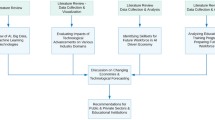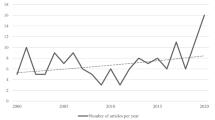Abstract
Small firms have been identified as drivers of job creation, although the evidence on their contribution to net employment growth has been disputed. This article shows that job turnover and firm growth vary systematically across firm size groups and that smaller firms do indeed make an important contribution to new job creation. There is a significant caveat, however; we find that it is not firm size per se that is driving these results but rather firm age. We show that younger firms are consistently more dynamic than older firms. We also find a strong inverse relationship between employment growth and size for young firms, but this declines very markedly for older age groups. This provides some support for the Gibrat’s law prediction that size and growth are independent, but only once the firm has moved beyond the start-up stage.





Similar content being viewed by others
Notes
See also the reply by Carree and Klomp (1996).
A very brief description of the rules can be found here: http://www.citizensinformation.ie/en/money_and_tax/personal_finance/debt/what_is_bankruptcy.html#l1f4da.
Downloaded from http://www.census.gov/ces/dataproducts/bds/.
Large start-ups and increases in employment are checked by the agency to ensure that they are genuinely new businesses and not new registrations because of name changes or mergers. Foreign-owned “entrants” on the other hand may have establishments already in existance in the country of origin.
This article focuses on aggregate effects of entry and exit, but interesting spillover dynamics can exist at the sector level. Examining how firm entry affected employment within and across sectors, Andersson and Noseleit (2011) found that start-up firms in a sector have a positive impact on employment change in the same sector but also that there was the potential for spillover effects in other sectors. Start-up activity in manufacturing and low-end services had positive effects on employment growth in other sectors, apparently due to a demand effect. However, this effect is not necessarily always positive, with start-ups in high-end services having a significant negative impact on employment change in other sectors with structural change through displacement outweighing any positive demand effect.
These and other robustness results are available on request.
This leads to the further question of what determines start-up size, but this is beyond the scope of the current paper. See Görg and Strobl (2002) for more on this topic.
Unweighted results give a similar pattern and are available on request.
References
Andersson, M., & Noseleit, F. (2011). Start-ups and employment dynamics within and across sectors. Small Business Economics, 36(4), 461–483.
Audretsch, D. B., & Mahmood, T. (1995). New-firm survival: New results using a hazard function. Review of Economics and Statistics, 77, 97–103.
Barry, F., & Bradley, J. (1997). FDI and trade: The Irish host-country experience. The Economic Journal, 107(445), 1798–1811.
Barry, F., Strobl, E. A., & Walsh, P. P. (1998). Aggregate job creation, job destruction and job turnover in the Irish manufacturing sector. Economic and Social Review, 29(1), 55–71.
Birch, D. L. (1981). Who creates jobs?. The Public Interest, 65, 3–14.
Carree, M., & Klomp, L. (1996). Small business and job creation: A comment. Small Business Economics, 8, 317–322.
Davis, S., & Haltiwanger, J. (1992). Gross job creation, gross job destruction, and employment reallocation. The Quarterly Journal of Economics, 107(3), 817–863.
Davis, S., & Haltiwanger, J. (1999). Gross Job Flows. In O. Ashenfelter & D. Card (Eds.), Handbook of labor economics. Amsterdam: North Holland/Elsevier Science.
Davis, S., Haltiwanger, J., & Schuh, S. (1996). Small business and job creation: Dissecting the myth and reassessing the facts. Small Business Economics, 8, 297–315.
Ferrando, A., & Griesshaber, N. (2011). Financing obstacles among Euro area firms: Who suffers the most? European Central Bank Working Paper Series, No. 1293.
Fort, T. C., Haltiwanger, J., Jarmin, R. S., & Miranda, J. (2013). How firms respond to business cycles: The role of firm age and firm size. NBER working paper no.19134.
Gomez-Salvador, R., Messina, J., & Vallanti, G. (2004). Gross job flows and institutions in Europe. Labour Economics, 11(4), 469–485.
Görg, H., & Strobl, E. (2002). Multinational companies and entrant start-up size: Evidence from quantile regressions. Review of Industrial Organization, 20, 15–31.
Haltiwanger, J., Scarpetta, S., & Schweiger, H. (2008). Assessing job flows across countries: The role of industry, firm size and regulations. NBER working paper no.13920.
Haltiwanger, J., Jarmin, R., & Miranda, J. (2013). Who creates jobs? Small vs large vs young. Review of Economics and Statistics, 95(2), 347–361.
Henrekson, M., & Johansson, D. (2010). Gazelles as job creators: A survey and interpetation of the evidence. Small Business Economics, 35(2), 227–244.
Jovanovic, B. (1982). Selection and the evolution of industry. Econometrica, 50(3), 649–670.
Lawless, M., & Murphy, A. (2008). Job Turnover in Irish Manufacturing 1972–2006. Economic and Social Review, 39(3), 235–256.
Lawless, M. (2012). Job creation and destruction in recession. Economic Letter Series, 2012, No. 1, Central Bank of Ireland.
Neumark, D., Wall, B., & Zhang, J. (2011). Do small businesses create more jobs? New evidence for the United States from the national establishment time series. The Review of Economics and Statistics, 93(1), 16–29.
Santarelli, E., Klomp, L., & Thurik, A. R. (2006). Gibrat’s law: An overview of the empirical literature. In E. Santarelli (Eds.), Entrepreneurship, growth, and innovation: The dynamics of firms and industries: International studies in Entrepreneurship.. Berlin: Springer Science.
Segarra, A., & Callejon, M. (2002). New firms’ survival and market turbulence: New evidence from spain. Review of Industrial Organization, 20, 1–14.
Sutton, J. (1997). Gibrat’s legacy. Journal of Economic Literature, 35(1), 40–59.
Author information
Authors and Affiliations
Corresponding author
Additional information
I would like to thank Forfás, and in particular Deborah Quinn and Paul Connolly, for providing the anonymised survey data and Patrick Honohan and Gerard O’Reilly for comments. The views expressed in this article are my own and do not necessarily reflect the views of the Central Bank of Ireland or the ESCB.
Appendix
Rights and permissions
About this article
Cite this article
Lawless, M. Age or size? Contributions to job creation. Small Bus Econ 42, 815–830 (2014). https://doi.org/10.1007/s11187-013-9513-9
Accepted:
Published:
Issue Date:
DOI: https://doi.org/10.1007/s11187-013-9513-9





